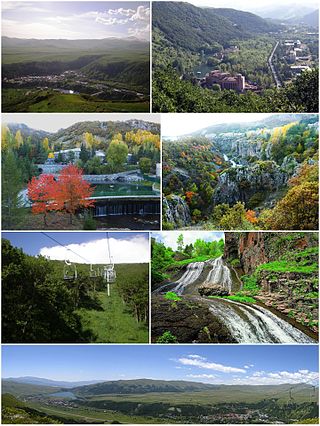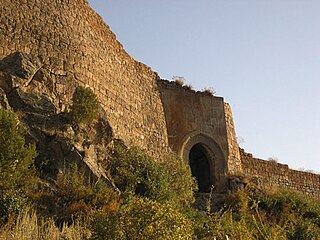David V, of the Bagrationi Dynasty, was a 7th king of Georgia in 1154 before his death in 1155

Jermuk is a mountain spa town and the centre of the Jermuk Municipality of the Vayots Dzor Province in southern Armenia, at a road distance of 53 km (33 mi) east of the provincial capital Yeghegnadzor. It was considered one of the popular destinations for medical tourism in the Soviet Union.
Demna was a Georgian royal prince and pretender to the throne proclaimed as king during the failed nobles’ revolt of 1177/8.
The Liparitids, also known as Baghuashi (ბაღჳაში), were a noble house (didebuli) in medieval Georgia, with notable members from the 9th to 12th centuries. They were famed for their powerful resistance to the consolidation of Bagratid royal authority in the Kingdom of Georgia. A principal branch of the Liparitid house, known later under the name of Orbeli or Orbeliani, were expelled in 1177 after a failed coup to Armenia where they came to be known as the Orbelian Dynasty, and controlled Syunik and Vayots Dzor until the invasions of Timur. Several cadet branches of the Liparitids have survived in Georgia for several centuries.

Alexander I the Great, of the Bagrationi house, was king of Georgia from 1412 to 1442. Despite his efforts to restore the country from the ruins left by the Turco-Mongol warlords and Timur's invasions, Georgia never recovered and faced the inevitable fragmentation that was followed by a long period of stagnation. Alexander was the last ruler of a united Georgia which was relatively free from foreign domination. In 1442, he abdicated the throne and retired to a monastery.

Noravank is a 13th-century Armenian monastery, located 122 km from Yerevan in a narrow gorge made by the Amaghu River, near the town of Yeghegnadzor in Armenia. The gorge is known for its tall, sheer, brick-red cliffs, directly across from the monastery. The monastery is best known for its two-storey Surb Astvatsatsin Church, which grants access to the second floor by way of a narrow stone-made staircase jutting out from the face of building.

Mongol conquests of Kingdom of Georgia, which at that time consisted of Georgia proper, Armenia, and much of the Caucasus, involved multiple invasions and large-scale raids throughout the 13th century. The Mongol Empire first appeared in the Caucasus in 1220 as generals Subutai and Jebe pursued Muhammad II of Khwarezm during the destruction of the Khwarezmian Empire. After a series of raids in which they defeated the combined Georgian and Armenian armies, Subutai and Jebe continued north to invade Kievan Rus'.
Momik was an Armenian architect, sculptor and a master artist of Armenian illuminated manuscripts. As a sculptor, Momik is also known for his fine carving of khachkars, found primarily at the monastery complex at Noravank. He held an eminent position at the Gladzor School of Illuminated Manuscripts in Syunik, established at Vayots Dzor under the patronage of the Orbelian family's historian, Stepanos Orbelian. Of the manuscripts authored by Momik, only several survive: one is found at the repository of the Mekhitarist Order in Vienna and three others are found at the Mashtots Institute of Ancient Manuscripts in Yerevan, Armenia.

Akhtala, also known as Pghindzavank is a 10th-century Armenian Apostolic monastery located in the town of Akhtala in the marz of Lori, 185 kilometers (115 mi) north of Yerevan and 87 kilometers south of Tbilisi. The monastery is currently inactive. The fortress played a major role in protecting the north-western regions of Armenia (Gugark) and is among the most well preserved of all in modern Armenia. The main church at the compound is famous for its highly artistic frescoes, which cover the inside walls, the partitions, and the bearings of the building. The modern name of Akhtala was first recorded in a royal decree of 1438. The etymology of the name Akhtala is believed to be of Turkic origin, meaning white glade. The original Armenian name of the settlement where the monastery is built is Pghindzahank, which means copper mine.

The Tatev Monastery is a 9th-century Armenian Apostolic monastery located on a large basalt plateau near the village of Tatev in the Syunik Province in southeastern Armenia. The term "Tatev" usually refers to the monastery. The monastic ensemble stands on the edge of a deep gorge of the Vorotan River. Tatev is known as the bishopric seat of Syunik and played a significant role in the history of the region as a center of economic, political, spiritual and cultural activity.
Stepanos Orbelian was a thirteenth-century Armenian historian and the metropolitan bishop of the province of Syunik. He is known for writing his well-researched History of the Province of Syunik.

Smbataberd is a medieval fortress located upon the crest of a hill between the villages of Artabuynk and Yeghegis in the Vayots Dzor Province of Armenia. It may have existed as early as the 5th century or earlier, although other sources date it to the 9th to 11th centuries. Its large basalt walls have been well preserved, but much less remains of the structures inside the fortress. It served as the main fortress of the Armenian princes of Syunik when Yeghegis was the seat of the rulers of that province. It was further expanded in the 13th century under the Orbelian dynasty. It is now a notable tourist site in Vayots Dzor.

Vorotnavank is a monastic complex located along a ridge overlooking the Vorotan gorge, between the villages of Vaghatin and Vorotan in the Syunik Province of Armenia. The complex is surrounded by a high stone wall for defense against foreign invasions and once housed workshops, stores, a seminary, resort, cemetery and an alms-house. A pillar stood in the yard of the monastery symbolizing that there were monks entering into religious service and kings inaugurated at this location. Hovhan Vorotnetsi (1315-1398), an Armenian medieval philosopher and theologian as well as the founder of Tatev Vardapetaran University lived and worked at the monastery.

Vorotnaberd is an important fortress along a ridge overlooking the Vorotan gorge, between the villages of Vaghatin and Vorotan in the Syunik Province of Armenia. Vorotnaberd is 1,365 metres (4,478 ft) above sea level.
Zakare Zakaryan or Zakaria II Mkhargrdzeli, was an Armenian general of Queen Tamar of Georgia army during the late 12th and early 13th centuries. He was the ruler of feudal lands in the Kingdom of Georgia.

Syunik was a region of historical Armenia and the ninth province of the Kingdom of Armenia from 189 BC until 428 AD. From the 7th to 9th centuries, it fell under Arab control. In 821, it formed two Armenian principalities: Kingdom of Syunik and principality of Khachen, which around the year 1000 was proclaimed the Kingdom of Artsakh, becoming one of the last medieval eastern Armenian kingdoms and principalities to maintain its autonomy following the Turkic invasions of the 11th to 14th centuries.
The Battle of Khunan was fought in September 1222 between the Kingdom of Georgia, led by King George IV, and the Mongol army led by Subutai and Jebe. The result was a Mongol victory. For further details, see the Mongol Invasions of Georgia.
Avag Mkhargrdzeli or Zakarian was a Georgian noble of Armenian descent, he was atabeg and amirspasalar of Georgia during the 13th century.

The Kiurikian or Kiurikid dynasty was a medieval Armenian royal dynasty which ruled the kingdoms of Tashir-Dzoraget (978-1118) and Kakheti-Hereti (1029/1038-1105). They originated as a junior branch and vassals of the Bagratid dynasty, but outlived the main branch of the dynasty after the fall of the Bagratid Kingdom of Armenia. They became vassals of the Seljuk Turks in the second half of the 1060s. After the fall of the Kingdom of Tashir-Dzoraget to the Seljuks in the early 12th century, members of the dynasty continued to rule from their fortresses of Tavush, Matsnaberd and Nor Berd until the 13th century.












